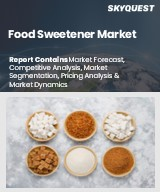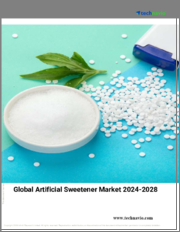
|
시장보고서
상품코드
1627575
시클라메이트 시장 : 예측(2025-2030년)Cyclamate Market - Forecasts from 2025 to 2030 |
||||||
시클라메이트 시장은 2025년에 19억 6,500만 달러로 연평균 4.77%로 성장하여 2030년에는 24억 8,100만 달러에 달할 것으로 예상됩니다.
시클라메이트는 인공 감미료로 설탕의 거의 30배에서 50배의 단맛이 있는 것으로 보고되고 있으며, 현재 시판되고 있는 감미료 중 가장 약효가 약한 감미료로 1937년 Michael Sveda가 일리노이 대학에서 발견했습니다. 일반적으로 수크랄로스보다 저렴하고 열에 안정적입니다. 일반적으로 사카린이나 아세설팜 칼륨보다 덜한 것으로 여겨지지만 일반적으로 좋지 않은 뒷맛을 남깁니다. 시클라메이트는 다른 감미료, 특히 사카린과 함께 시너지 효과를 내기 위해 종종 다른 감미료와 함께 사용되며, 이질적인 맛을 가리고 수크랄로스보다 훨씬 저렴합니다. 가장 저렴한 열 안정성 감미료입니다. 가장 일반적인 용도 중 하나는 시너지 효과를 얻기 위해 사카린과 결합하여 시너지 효과를 얻는 것입니다.
또한 감미료인 시클라메이트는 인체에 미치는 악영향에 대한 논쟁이 치열하게 벌어지고 있습니다. 고용량 섭취는 동물의 방광암과 고환 위축을 유발하는 것으로 알려져 미국 식품의약국은 시클라메이트를 식품에서 금지하고 있습니다. 그러나 시클라메이트는 일반적인 사용 수준에서는 안전하다는 의견도 많아 55개국 이상에서 사용을 허용하고 있습니다. 시클라메이트는 EU에서는 안전한 것으로 간주되어 식품, 특히 음료에 사용이 허가되어 있습니다. 미국에서는 식품에 사용이 허용되지 않지만 치약이나 구강청결제와 같은 비식품 재료에는 일반적으로 사용되고 있습니다.
시클라메이트 시장은 식음료 분야에서 저칼로리 감미료가 소비자들에게 받아들여지면서 지속적으로 성장하고 있습니다. 주요 성장 요인으로는 사람들의 건강 지향성, 식품에 칼로리를 추가하지 않고 단맛을 내는 시클라메이트의 능력, 비용 효율성, 고온 안정성 등을 들 수 있습니다. 그러나 시장에 존재하는 장벽에는 특정 국가의 규제 제한과 안전성에 대한 우려가 있습니다. 시클라메이트는 일반적으로 안전하다고 알려져 있지만, 건강에 미치는 영향에 대한 우려를 나타내는 연구는 거의 없습니다. 이러한 문제에도 불구하고, 시클라메이트 시장은 확대될 가능성이 높습니다.
시클라메이트 시장의 촉진요인:
- 식음료 산업의 성장은 시클라메이트 시장의 성장을 촉진할 것으로 예상됩니다.
시클라메이트 시장은 활발한 식음료 산업과의 관계로 인해 상당히 빠른 성장이 예상됩니다. 가처분 소득의 증가와 라이프스타일 트렌드의 변화로 인해 더 건강한 대체품 및 저칼로리, 무설탕 제품에 대한 니즈가 증가하고 있습니다.
아시아태평양과 같은 신흥 시장도 그 속도를 높이고 있습니다. 아시아태평양의 식음료 산업은 빠르게 성장하고 있으며, 이는 시크라메트에게 새로운 비즈니스 기회를 제공하고 있습니다.
인도 과학기술부의 인도 식품 및 음료 SSI 조사(IFBSSI)에 따르면 인도의 식품 가공 산업은 2025-2026년 사이 5,350억 달러에 달할 것으로 예상됩니다. 또한, 세계 산업 자동화 시장은 2026년까지 2,970억 달러로 성장할 것으로 예상되며, 식음료 응용 분야는 시장의 11%를 차지하여 시장 공간에서 시클라메트의 수요를 촉진할 것으로 예상됩니다.
또한 많은 제품에서 설탕을 줄이는 비 칼로리 감미료입니다. 그 사용은 일부 국가에서는 논란의 여지가 있지만, 많은 지역에서 널리 받아들여지고 사용되고 있습니다. 그 비용 효율성은 제조업체에게 매력적인 선택이 되고 있습니다. 식음료 산업의 지속적인 번영과 건강에 대한 관심이 높아짐에 따라 시클라메이트는 미래에 큰 기회를 가지고 있습니다.
시클라메이트 시장의 지리적 전망:
- 아시아태평양이 시클라메이트 시장에서 큰 비중을 차지할 것으로 예상됩니다.
중국, 인도, 인도네시아와 같은 국가들은 급속한 경제 성장으로 식음료에 대한 수요 증가를 주도하고 있습니다. 이러한 요인들이 복합적으로 작용하여 아시아태평양이 감미료의 주요 시장이 될 것으로 예상되는 시클라메이트에 대한 수요를 촉진할 것으로 예상됩니다. 이 지역이 계속 발전하고 인구가 증가함에 따라 저칼로리, 무설탕 대안에 대한 수요가 증가함에 따라 시클라메이트의 주요 시장으로 확고히 자리매김할 것으로 예상됩니다.
중국, 인도, 인도네시아와 같은 국가들은 이미 빠른 성장세를 보이고 있으며, 식음료에 대한 수요를 증가시키고 있습니다. 이러한 요인들이 결합되어 이 지역은 시클라메이트 감미료의 중요한 시장 중 하나가 되었습니다. 인구 증가와 발전에 따라 저칼로리 제품 및 무설탕 제품에 대한 수요가 증가함에 따라 아시아태평양은 시클라메이트의 중요한 시장으로 부상하고 있습니다.
이 보고서를 구매해야 하는 이유
- 통찰력 있는 분석 : 고객 부문, 정부 정책 및 사회경제적 요인, 소비자 선호도, 산업별, 기타 하위 부문에 초점을 맞추고 주요 지역뿐만 아니라 신흥 지역까지 포괄하는 상세한 시장 인사이트를 얻을 수 있습니다.
- 경쟁 상황 : 세계 주요 기업들이 채택하고 있는 전략적 전략을 이해하고, 올바른 전략을 통한 시장 침투 가능성을 이해할 수 있습니다.
- 시장 동향과 촉진요인 : 역동적인 요인과 매우 중요한 시장 동향, 그리고 이들이 향후 시장 발전을 어떻게 형성할 것인지에 대해 알아봅니다.
- 실행 가능한 제안 : 역동적인 환경 속에서 새로운 비즈니스 스트림과 수익을 발굴하기 위한 전략적 의사결정을 내릴 수 있도록 인사이트를 활용합니다.
- 다양한 사용자에 대응 : 스타트업, 연구기관, 컨설턴트, 중소기업, 대기업에 유익하고 비용 효율적입니다.
어떤 용도로 사용되는가?
산업 및 시장 인사이트, 사업 기회 평가, 제품 수요 예측, 시장 진입 전략, 지리적 확장, 설비 투자 결정, 규제 프레임워크 및 영향, 신제품 개발, 경쟁의 영향
조사 범위
- 2022-2030년 실적 데이터 및 예측
- 성장 기회, 도전과제, 공급망 전망, 규제 프레임워크, 고객 행동, 트렌드 분석
- 경쟁사 포지셔닝, 전략 및 시장 점유율 분석
- 매출 성장 및 예측 국가를 포함한 부문 및 지역별 분석
- 기업 프로파일링(전략, 제품, 재무상태, 주요 발전 등)
시클라메이트 시장은 다음과 같이 세분화되어 분석됩니다:
유형별
- 시클라민산
- 나트륨 시클라메이트
- 칼슘 시클라메이트
최종사용자별
- 식음료
- 의약품
- 화장품 및 퍼스널케어
- 기타
지역별
- 북미
- 미국
- 캐나다
- 멕시코
- 남미
- 브라질
- 아르헨티나
- 기타
- 유럽
- 영국
- 독일
- 프랑스
- 이탈리아
- 기타
- 중동 및 아프리카
- 사우디아라비아
- UAE
- 기타
- 아시아태평양
- 중국
- 일본
- 인도
- 한국
- 인도네시아
- 기타
목차
제1장 소개
- 시장 개요
- 시장 정의
- 조사 범위
- 시장 세분화
- 통화
- 가정
- 기준 연도와 예측 연도 타임라인
- 이해관계자에 대한 주요 이점
제2장 조사 방법
- 조사 설계
- 조사 과정
제3장 주요 요약
- 주요 조사 결과
제4장 시장 역학
- 시장 성장 촉진요인
- 시장 성장 억제요인
- Porter's Five Forces 분석
- 업계 밸류체인 분석
- 애널리스트의 견해
제5장 시클라메이트 시장 : 유형별
- 소개
- 시클라민산
- 나트륨 시클라메이트
- 칼슘 시클라메이트
제6장 시클라메이트 시장 : 최종사용자별
- 소개
- 식품 및 음료
- 의약품
- 화장품·퍼스널케어
- 기타
제7장 시클라메이트 시장 : 지역별
- 소개
- 북미
- 유형별
- 최종사용자별
- 국가별
- 남미
- 유형별
- 최종사용자별
- 국가별
- 유럽
- 유형별
- 최종사용자별
- 국가별
- 중동 및 아프리카
- 유형별
- 최종사용자별
- 국가별
- 아시아태평양
- 유형별
- 최종사용자별
- 국가별
제8장 경쟁 환경과 분석
- 주요 기업과 전략 분석
- 시장 점유율 분석
- 합병, 인수, 합의, 협업
- 경쟁 대시보드
제9장 기업 개요
- Foodchem International Corporation
- PT. Batang Alum Industrie
- Productos Aditivos, S.A.
- Golden Time Enterprises Limited
- Prakash Chemicals International Private Limited(PCIPL)
- Tongaat Hulett
- Jebsen & Jessen Life Science GmbH
- Ataman Chemicals
The cyclamate market is valued at US$1.965 billion in 2025 and is expected to grow at a compound annual growth rate of 4.77% to reach a market size of US$2.481 billion in 2030.
Cyclamate is an artificial sweetener, reported to be almost thirty to fifty times sweeter than sugar, making it the least potent among currently available commercial sweeteners. Michael Sveda discovered it at the University of Illinois as early as 1937. It is typically cheaper than sucralose and heat-stable. While this usually leaves an undesirable aftertaste, it is generally considered to be less than saccharin or acesulfame potassium. Cyclamate is mostly used synergistically with other sweeteners, especially with saccharin, to mask off-taste and is much less expensive than sucralose. It is the most affordable heat-stable sweetener. One of the most common uses is to combine it with saccharin to get a synergistic effect.
Additionally, cyclamate as a sweetener has been subject to heated debate regarding its adverse effects on humans. It has been said that high doses are linked to cases of bladder cancer and testicular atrophy among animals, thus banning cyclamate from food products by the U.S. Food and Drug Administration. However, many argue that cyclamate is safe to use under normal usage levels, with more than 55 countries approving its use. Cyclamate is considered safe by the European Union, allowing it to be used in foods, particularly in beverages. It is not permitted in the U.S. for food uses, but it is ordinarily used in nonfood materials like toothpaste and mouthwash.
The cyclamate market is consistently growing due to increasing consumer acceptance of low-calorie sweeteners in the food and beverage sectors. Some important growth factors include people's health consciousness, cyclamate's ability to provide sweetness without adding calories to the food, its cost-effectiveness, and high-temperature stability. However, the existing barriers in the market include regulatory restrictions in certain countries and safety concerns. Though cyclamate is said to be safe generally, few studies raise concerns about its health effects. Despite these issues, the cyclamate market is highly probable to expand because more people are inclined towards low-calorie sweeteners.
Cyclamate market drivers:
- The growing food and beverage industry is expected to fuel the cyclamate market growth.
The cyclamate market is anticipated to witness a considerable surge owing to its relation with the thriving food and beverage industry. The growing need for healthier alternatives and low-calorie and sugar-free products is largely driven by rising disposable income and changing lifestyle trends.
Emerging markets like Asia-Pacific are also stepping up their pace. They are growing rapidly in their food and beverage industry, offering new opportunities to form new business leads for cyclamate.
Based on the information derived from the Department of Science & Technology titled "Indian Food & Beverages SSI Survey" (IFBSSI), the Indian food processing industry is expected to reach $535 billion by FY 2025-26 while having huge investment opportunities in the food retail sector due to favorable policies and fiscal incentives. Further, the global industrial automation market is projected to grow to $297 billion by 2026, where food and beverage applications hold 11% of the market, promoting the demand for cyclamate in the market space.
Additionally, it is a non-caloric sweetening agent that reduces sugar content in many commodities. Its usage has been controversial in some countries but is widely accepted and used in many regions. Its cost-effectiveness is becoming an attractive alternative for manufacturers as well. With the continuously thriving food and beverage industries and the increasing demand for healthier options, cyclamate has a great opportunity for future establishment.
Cyclamate market Geographical outlooks:
- Asia Pacific is expected to have a significant cyclamate market share.
Countries like China, India, and Indonesia are experiencing rapid economic growth, driving increased demand for food and beverage products. The combination of these factors is expected to fuel the demand for cyclamate in the Asia-Pacific region, making it a major market for this sweetener. As the region continues to develop and its population grows, the demand for low-calorie and sugar-free options will likely increase, solidifying the region's position as a key market for cyclamate.
Countries like China, India, and Indonesia have already shown fast growth acceleration, increasing demand for food and beverage products. Combining these factors makes this region one of the important markets for cyclamate sweeteners. As the population increases and develops, the demand for low-calorie and sugar-free products will increase in the region, making Asia Pacific a key market in cyclamate.
Reasons for buying this report:-
- Insightful Analysis: Gain detailed market insights covering major as well as emerging geographical regions, focusing on customer segments, government policies and socio-economic factors, consumer preferences, industry verticals, other sub- segments.
- Competitive Landscape: Understand the strategic maneuvers employed by key players globally to understand possible market penetration with the correct strategy.
- Market Drivers & Future Trends: Explore the dynamic factors and pivotal market trends and how they will shape up future market developments.
- Actionable Recommendations: Utilize the insights to exercise strategic decision to uncover new business streams and revenues in a dynamic environment.
- Caters to a Wide Audience: Beneficial and cost-effective for startups, research institutions, consultants, SMEs, and large enterprises.
What do businesses use our reports for?
Industry and Market Insights, Opportunity Assessment, Product Demand Forecasting, Market Entry Strategy, Geographical Expansion, Capital Investment Decisions, Regulatory Framework & Implications, New Product Development, Competitive Intelligence
Report Coverage:
- Historical data & forecasts from 2022 to 2030
- Growth Opportunities, Challenges, Supply Chain Outlook, Regulatory Framework, Customer Behaviour, and Trend Analysis
- Competitive Positioning, Strategies, and Market Share Analysis
- Revenue Growth and Forecast Assessment of segments and regions including countries
- Company Profiling (Strategies, Products, Financial Information, and Key Developments among others)
The Cyclamate Market is segmented and analyzed as below:
By Type
- Cyclamic Acid
- Sodium Cyclamate
- Calcium Cyclamate
By End-User
- Food and Beverages
- Pharmaceuticals
- Cosmetics and Personal Care
- Others
By Geography
- North America
- USA
- Canada
- Mexico
- South America
- Brazil
- Argentina
- Others
- Europe
- United Kingdom
- Germany
- France
- Italy
- Others
- Middle East and Africa
- Saudi Arabia
- UAE
- Others
- Asia Pacific
- China
- Japan
- India
- South Korea
- Indonesia
- Others
TABLE OF CONTENTS
1. INTRODUCTION
- 1.1. Market Overview
- 1.2. Market Definition
- 1.3. Scope of the Study
- 1.4. Market Segmentation
- 1.5. Currency
- 1.6. Assumptions
- 1.7. Base and Forecast Years Timeline
- 1.8. Key benefits for the stakeholders
2. RESEARCH METHODOLOGY
- 2.1. Research Design
- 2.2. Research Process
3. EXECUTIVE SUMMARY
- 3.1. Key Findings
4. MARKET DYNAMICS
- 4.1. Market Drivers
- 4.2. Market Restraints
- 4.3. Porter's Five Forces Analysis
- 4.3.1. Bargaining Power of Suppliers
- 4.3.2. Bargaining Power of Buyers
- 4.3.3. Threat of New Entrants
- 4.3.4. Threat of Substitutes
- 4.3.5. Competitive Rivalry in the Industry
- 4.4. Industry Value Chain Analysis
- 4.5. Analyst View
5. CYCLAMATE MARKET BY TYPE
- 5.1. Introduction
- 5.2. Cyclamic Acid
- 5.3. Sodium Cyclamate
- 5.4. Calcium Cyclamate
6. CYCLAMATE MARKET BY END-USER
- 6.1. Introduction
- 6.2. Food and Beverages
- 6.3. Pharmaceuticals
- 6.4. Cosmetics and Personal Care
- 6.5. Others
7. CYCLAMATE MARKET BY GEOGRAPHY
- 7.1. Introduction
- 7.2. North America
- 7.2.1. By Type
- 7.2.2. By End-User
- 7.2.3. By Country
- 7.2.3.1. USA
- 7.2.3.2. Canada
- 7.2.3.3. Mexico
- 7.3. South America
- 7.3.1. By Type
- 7.3.2. By End-User
- 7.3.3. By Country
- 7.3.3.1. Brazil
- 7.3.3.2. Argentina
- 7.3.3.3. Others
- 7.4. Europe
- 7.4.1. By Type
- 7.4.2. By End-User
- 7.4.3. By Country
- 7.4.3.1. United Kingdom
- 7.4.3.2. Germany
- 7.4.3.3. France
- 7.4.3.4. Italy
- 7.4.3.5. Others
- 7.5. Middle East and Africa
- 7.5.1. By Type
- 7.5.2. By End-User
- 7.5.3. By Country
- 7.5.3.1. Saudi Arabia
- 7.5.3.2. UAE
- 7.5.3.3. Others
- 7.6. Asia Pacific
- 7.6.1. By Type
- 7.6.2. By End-User
- 7.6.3. By Country
- 7.6.3.1. China
- 7.6.3.2. Japan
- 7.6.3.3. India
- 7.6.3.4. South Korea
- 7.6.3.5. Indonesia
- 7.6.3.6. Others
8. COMPETITIVE ENVIRONMENT AND ANALYSIS
- 8.1. Major Players and Strategy Analysis
- 8.2. Market Share Analysis
- 8.3. Mergers, Acquisitions, Agreements, and Collaborations
- 8.4. Competitive Dashboard
9. COMPANY PROFILES
- 9.1. Foodchem International Corporation
- 9.2. PT. Batang Alum Industrie
- 9.3. Productos Aditivos, S.A.
- 9.4. Golden Time Enterprises Limited
- 9.5. Prakash Chemicals International Private Limited (PCIPL)
- 9.6. Tongaat Hulett
- 9.7. Jebsen & Jessen Life Science GmbH
- 9.8. Ataman Chemicals



















